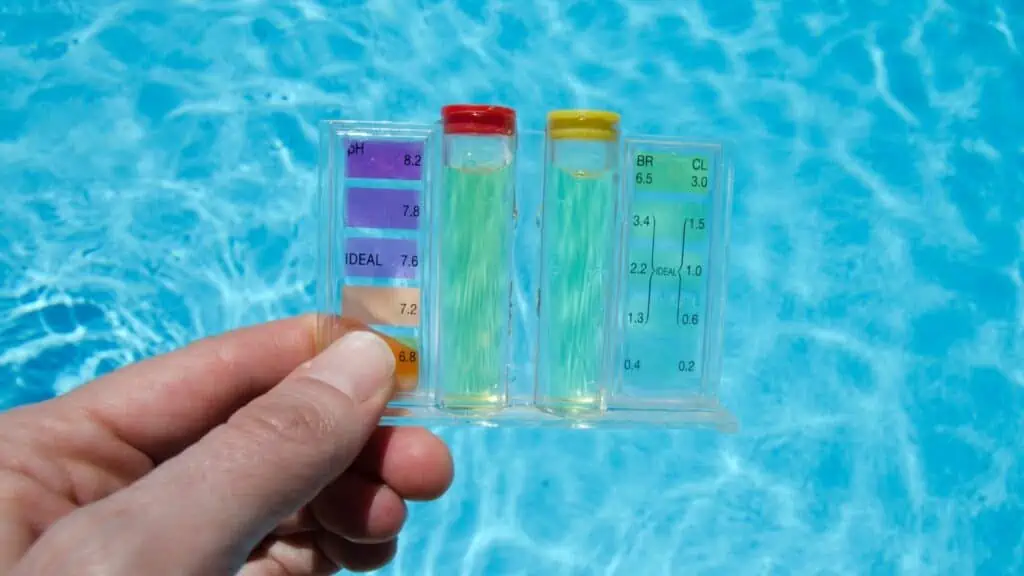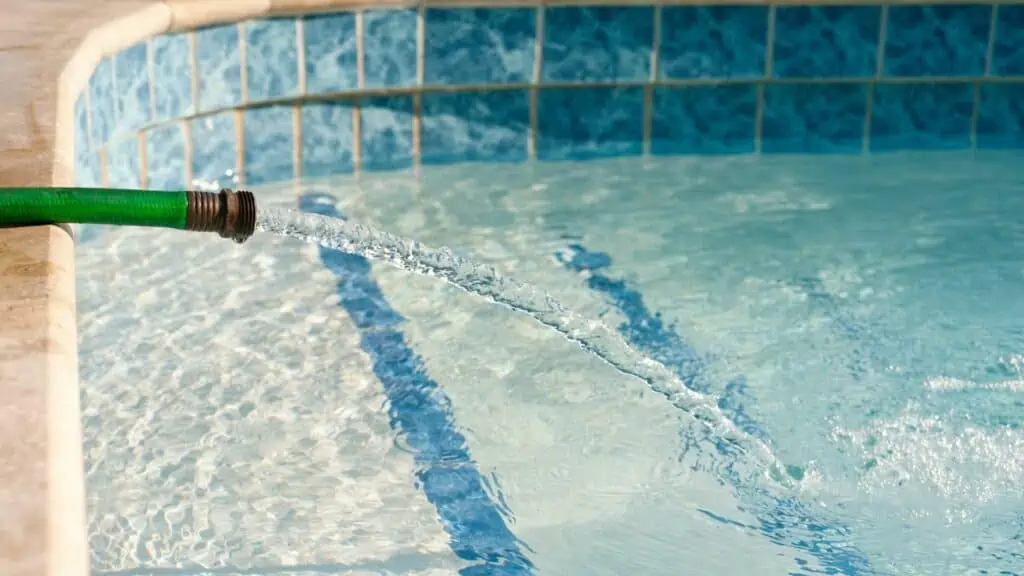Cyanuric acid (also known as CYA) is a chemical that is used as a pool stabilizer to control free chlorine levels. It helps to keep chlorine from dissipating quickly, which helps to maintain its constant level in the pool. Cyanuric acid protects free chlorine against the effects of UV rays from the sun.
To lower or raise cyanuric acid levels, you will need to test the water and adjust the levels as necessary. If the CYA level is too high, you can dilute it by adding fresh water. If the acid level is too low, you can add liquid cyanuric acid to the water.
Cyanuric acid is a colorless, water-soluble compound that is used to lower the pH level of the water. It can be used in conjunction with other pool management methods, such as the addition of sodium bicarbonate to help control the acidity of the pool.


What are the right cyanuric acid levels?

A perfect balance and level of cyanuric acid are important to keep the pool clean and healthy. The ideal range for chlorine stabilizer, or cyanuric acid (CYA), is between 30-50 ppm.
This can vary based on the type of pool, water balance, and other factors. Using a range is more accurate, but in most cases, the level should be between 30-50 ppm.
All things considered, obtaining the exact ratio between cyanuric acid and chlorine is crucial. The levels should make up 7.5% of the cyanuric acid levels. For example, once the cya levels reach 40 ppm, make sure to keep free chlorine levels at three ppm.
Nonetheless, if you own a saltwater pool, you have to raise cyanuric acid levels. The sun’s UV rays are that much more dangerous if the water is salty. In that case, the sun’s UV rays impact both the salt and the chlorine generated from the salt.
For saltwater pools, it is recommended to keep the cya level between 60 and 80 ppm.
More cyanuric acid does not always mean better protection. In some situations, high cya levels may result in algae growth or pool water that is not clean. Very high cya levels, for example, levels of 100 ppm or higher, will reduce the effectiveness of the chlorine and won’t get an accurate reading on a test strip.
If the levels are too high, we suggest taking a water sample to a supply store or using a test kit to measure cyanuric acid levels.
Also read: How to add pool stabilizer
What causes high cyanuric acid levels?
Cyanuric acid is a by-product of the chemical reaction that breaks down urea into nitrogen and water. It can form in pools when the levels of nitrogen and chlorine are too high or when the pool’s filter is not working properly.
Cyanuric acid can cause staining and scaling on pool surfaces and can also cause a decrease in the pH of the pool. To reduce the risk of high cya levels, keep the pool clean and maintain the filter.
Once you start adding chlorine to your water, you are probably adding cyanuric acid too. There are a lot of products in the market, such as trichlor granules or chlorine tablets, which are known as stabilized chlorine, as they come with cyanuric acid included.
However, if you are adding liquid chlorine or better known as unstabilized chlorine, you are not adding cyanuric acid at the same time. The great difference between stabilized and unstabilized chlorine is that the first one has cyanuric acid in it, and by adding that, you can unknowingly increase the cyanuric acid levels in your pool.
The bottom line is if you are adding pure chlorine without a stabilizer to your pool water, buy a separate product called either a pool stabilizer or pool conditioner.
Since cyanuric acid does not evaporate, you have to be very careful not to increase the cya levels. Because once the cya levels are high, it can be very hard to get them down.
Symptoms of high cyanuric acid in pool water
High cyanuric acid (CYA) levels in a swimming pool don’t directly cause symptoms in the water or to swimmers like chlorine or pH imbalances may do. Instead, the primary concern with elevated CYA levels is its impact on chlorine’s effectiveness as a disinfectant.
Here’s a breakdown of the issues associated with high cyanuric acid levels in pools:
- Reduced Chlorine Effectiveness: Cyanuric acid is used in pools to stabilize chlorine, preventing it from being rapidly depleted by the sun’s UV rays. However, when CYA levels are too high, it can make the chlorine less active, meaning it won’t sanitize or oxidize contaminants as effectively. This can lead to:
- Cloudy Water: Ineffective chlorine can’t combat algae and bacteria growth, which can make the water appear cloudy.
- Algae Blooms: Without sufficient active chlorine to kill algae, you may notice green, yellow, or black algae forming in the pool.
- Increased Chloramine Production: Chloramines are by-products formed when chlorine reacts with contaminants like sweat, urine, and other organic materials. High CYA levels can lead to reduced chlorine oxidation, which in turn can increase chloramine formation. Chloramines are responsible for the “chlorine smell” many associate with pools and can cause:
- Eye irritation
- Skin irritation
- Respiratory issues when inhaled
- Difficulty in Maintaining Proper Chlorine Levels: With high CYA, you might find yourself adding more and more chlorine to the pool to achieve the same sanitizing effect. This not only becomes costly but can also lead to over-chlorination if not monitored correctly.
- Potential for Calcium Scaling: While CYA itself doesn’t cause calcium scaling, the practices used to combat high CYA (like adding more chlorine) can raise the calcium hardness and pH of the pool, leading to scaling.
How to lower cyanuric acid in pool water

There is a very effective way to lower the cya levels immediately. You need to partially drain your pool and refill it with fresh water.
However, if you still think that the levels are too high, you can stop adding cyanuric acid or stabilized chlorine to your pool.
When cyanuric acid levels are high in a pool, it can cause a yellowish discoloration and an unpleasant odor.
Here are the necessary steps to lowering the presence of cya in your pool:
- Test the Pool Water
To check if the cya levels are between 30 and 50 ppm, you have to use test strips. If the levels are 100 or higher, you need to start lowering them. If you don’t have test strips with such high levels, your local pool supply store can offer one.
- Stop using Stabilized Chlorine
Check the label of the chlorine. If it includes potassium dichloroisocyanurate or trichloroisocyanurate, then you are using stabilized chlorine with cyanuric acid in your pool. Try switching to a pool stabilizer or pool conditioner that doesn’t contain cya.
- Dilute the Pool Water
When the cya level amount is higher than 100 ppm, you have to dilute the pool water. Drain some of the water using a pool pump, and then refill your pool with fresh water. Still, you won’t need to drain the entire pool. A general rule is to drain as much water as the % of cya that is off the chart. If the cya levels are 10% too high, then replace only 10% of your water.
- Circulate and retest
After running the pool pump for a few hours, retest the levels again. If they are still too high, you need to repeat the process and dilute more water.
A chlorine boost will also keep the water clean while reducing the risk of algae growth and will help decrease the amount of time needed to get rid of cyanuric acid.
You can use a pool shock such as calcium hypochlorite to increase chlorine levels, which will help reduce cyanuric acid.
Also, you can use an oxidizer such as potassium permanganate to oxidize cyanuric acid, which will help it break down into chlorine and form salts that can be removed by the filter.
Do cyanuric acid reducers work?
Using a cya reducer does not guarantee you will reduce the cya levels. The only way to do that is by diluting the water.
Reducers are biologically based, and it can take a whole week or more to reduce the cya level. Many customers who used cyanuric acid reducers are complaining because they don’t see any results.
A biological cya reducer is not cheap. For the same price that you can buy a reducer, you can drain and refill your pool partially.
However, if you are experiencing drought conditions or facing any restrictions about diluting the pool water, it might be worth trying to reduce the level by using a cyanuric acid reducer.
If you want to try it yourself, the Natural Chem CYA Removal Kit is available on Amazon.
How to raise cyanuric acid in pool water
It could be more simple. Add additional cyanuric acid. Here is how to do it.
Materials:
- Cyanuric acid (available in granular or liquid form)
- A bucket (if using granular form)
- Pool test kit or test strips
Steps:
- Test the Water: Before adding any chemicals to your pool, always test the water to determine the current CYA level. This will help you know how much cyanuric acid you need to add.
- Read the Product Label: Always read the manufacturer’s instructions on the cyanuric acid product you’re using. It will provide guidance on how much of the product to add based on your pool’s volume and the desired increase in CYA levels.
- Prepare the Cyanuric Acid:
- For Granular Form: a. Fill a bucket with warm water. b. Add the required amount of cyanuric acid granules to the bucket. c. Stir until the granules are dissolved as much as possible. Note: Cyanuric acid dissolves slowly, so it might not dissolve completely.
- For Liquid Form: Simply shake the container well before use.
- Add Cyanuric Acid to the Pool:
- For Granular Form: Slowly pour the dissolved cyanuric acid solution into the pool, spreading it around the pool’s perimeter.
- For Liquid Form: Pour the required amount of liquid cyanuric acid around the pool’s perimeter.
- Run the Pool Pump: Turn on your pool pump and let it run for at least 24 hours to circulate the cyanuric acid throughout the pool.
- Re-test the Water: After 24-48 hours, test the pool water again to ensure the CYA levels are where you want them. If necessary, repeat the process until you reach the desired level.
Tips:
- Always add chemicals to water, not water to chemicals.
- Avoid adding too much cyanuric acid at once. It’s easier to add more later if needed than to reduce high CYA levels.
- Aim for a CYA level between 30-50 ppm for non-saltwater pools and 70-80 ppm for saltwater pools. However, always consult with pool professionals or guidelines specific to your pool type and region.
How does cyanuric acid work?
The science
Cyanuric acid works to protect pool water against the effects of ultraviolet light. It does this by binding to chlorine molecules and forming salts that will not break down easily, which prevents them from dissolving in the water. This increases the effectiveness of the chlorine, subsequently increasing sanitization throughout the pool.
Because the cyanuric acid molecule has Nitrogen and Carbon atoms, it allows the three molecules of chlorine to attach to the nitrogen and create a weak nitrogen-chlorine bond. This weak bond allows chlorine to release cyanuric acids once it has something to oxidize (kill).
If this bond was stronger, chlorine would reveal on a total chlorine test, not free chlorine. Once the acid attaches to the chlorine, it acts like sunscreen, and the chlorine is protected from the sunlight.
It’s use in pools
If your outdoor pool doesn’t have cyanuric acid or pool stabilizer, it could take only 17 minutes until the sun’s UV rays eat up half of the pool’s chlorine. Without the cyanuric acid, you are leaving your swimming pool unprotected and unsanitized.
Pools with no cyanuric acid suffer from ‘chlorine demand’ and are unable to maintain the chlorine levels. If the pool’s water is used to having lower or no amount of cyanuric acid, then no matter how much you add, the chlorine levels will drop very quickly.
You can solve this problem by adding a stabilizer (without using other chemicals) that will help the chlorine last at least three times longer than usual.
I use In The Swim Pool Chlorine Stabilizer which you can buy on Amazon.
Why use cyanuric acid?
A chlorinated pool with cyanuric acid will not lose the chlorine when exposed to direct sunlight. Only without a stabilizer will the chlorine dissipate and would very soon leave the pool without free chlorine.
Cyanuric acid offers a lot of benefits for the pool industry simply because it allows homeowners or pool service professionals to manage the pool’s water chemistry frequently and with less effort. Due to this, service companies are free from taking care of emergency algae situations in many pools daily.
Cyanuric acid also helps to reduce the levels of algae and bacteria, which can cause green water and poor aesthetic appeal. It is also effective at reducing the levels of chlorine needed, which can save money on pool maintenance.
Cyanuric Acid: Friend or foe of swimming pools?

Many people still often think about other effects of cyanuric acid and the influence it has on the swimming pool water. Cyanuric acid also works as a stabilizer for all that chlorine in outdoor pools. It preserves the free chlorine in the pool from the sun’s ultraviolet rays, and by that, it helps reduce chlorine loss.
In this manner, liquid cyanuric acid helps maintain proper sanitizer levels by reducing the amount of chlorine. This means that if you add cyanuric acid, you can reduce the cost of maintaining a clean swimming pool.
Cyanuric acid is used as a stabilizer in many types of swimming pools, but it has been linked to several health concerns. Some people believe that it can cause skin irritation and eye problems, while others are concerned about its potential impact on the environment.
It is important to note that there is no evidence to support any of these claims. It is up to each individual to decide whether or not they want to use cyanuric acid in their pool.
For the owners of indoor pools and hot tubs, here is some good news: you don’t need to worry about cyanuric levels. Cyanuric acid protects chlorine from the sun’s UV rays, so unless indoor pools have some ultraviolet light exposure, owners do not have to worry about adding other chemicals.
Long after the water evaporates, the cyanuric acid stays inside the pool. For that reason, always make sure to check the cyanuric acid level before adding more stabilized chlorine to your water.
Conclusion
We all know that to get the chlorine levels stabilized, we need to use a pool stabilizer. This rule doesn’t apply if you are a lucky owner of an indoor pool or hot tubs.
However, owners of outdoor pools must use a pool stabilizer that will add cyanuric acid to the pool water and will help balance the pool chemistry.
Still, you do not want too much acid in your pool because too much cyanuric acid can be very tricky for pool owners.
But how much chlorine is enough? All things considered, your chlorine level should make up 7.5% of the cyanuric acid level. In other words, if the cya level is 40ppm, the chlorine level should be 3ppm.
Every little bacteria, algae, or microscopic contaminant takes a toll on the pool’s water chemistry. The best advice is to do a weekly preventive check so that you can help the chlorine last longer and kill bacteria more efficiently.
FAQs
Does shock raise cyanuric acid?
Shock does not raise the cyanuric acid levels in a pool as it is unstabilized chlorine, so it does contain any CYA.
What is the chemical that is used to stabilize the chlorine reading against the ultra-violet light of the sun in an outdoor pool?
The most common chemical that is used to stabilize the chlorine in a pool is Cyanuric Acid (CYA) whose chemical formula is C3H3N3O3.
Is cyanuric acid the same as baking soda?
Cyanuric acid is not the same as baking soda. In fact it is the opposite since baking soda is an alkaline and is used to raise the pH in a pool.








Leave a Reply